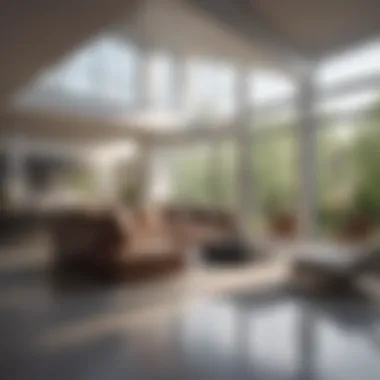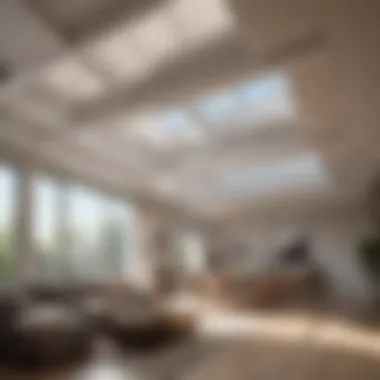The Impact of Raised Ceilings in Modern Design


Intro
Raised ceilings stand as a hallmark of modern architecture, blending style with substance to create more than just aesthetic appeal. These architectural features breathe life into living spaces, inviting an air of openness that many seek in contemporary design. As we explore the characteristics and advantages of raised ceilings, it becomes clear how they can alter the dynamics of any room, providing a unique interplay of light, space, and atmosphere.
But what exactly makes raised ceilings so significant? This article will dissect their many facets, from how they enhance luminosity and airflow to their integration in different design themes. We’ll also look at the practical steps required to incorporate these ceilings into your own projects, shedding light on the challenges that may arise during construction and maintenance.
With the growing trend in real estate and interior design focusing on more inviting and functional spaces, the role of raised ceilings cannot be overlooked. By the end of this exploration, the hope is to not just inform but also inspire those venturing into the nuanced world of modern architecture and design.
Preface to Raised Ceilings
When you step into a room with a raised ceiling, it's hard not to feel a wave of spaciousness wash over you. It’s as if the walls are whispering secrets of grandeur, inviting you to look up and appreciate the architecture. Raised ceilings have not only become a hallmark of modern design but they also infuse spaces with a sense of airiness and light that is hard to replicate. In this article, we delve into why raised ceilings are significant in contemporary architectural design.
Firstly, one must consider the overarching aesthetic appeal of raised ceilings. These architectural features create a visual experience that can transform a standard room into a breathtaking haven. They enhance the vertical dimension of interiors, making spaces look larger and more inviting. The play of light and shadows from nearby windows can dramatize wall textures, moldings, and furnishings in a manner that flatter their surroundings.
Moreover, the practical advantages are significant. Raised ceilings often lead to improved ventilation, allowing air to circulate more freely, refreshing the indoor atmosphere, especially during hot months. When the temperature rises, hot air tends to linger near the ceiling—having a higher roofline means that there's room for cooler air to settle below, improving comfort levels.
Considerations surrounding raised ceilings extend beyond mere aesthetics and comfort. Architects must carefully evaluate structural implications—higher ceilings mean more materials and specialized construction techniques, which can heighten costs. Additionally, the architectural style of the building must align with the decision to raise the ceiling, ensuring that it complements the overall design narrative of the space.
In essence, this introduction sets the stage for exploring the layered significance of raised ceilings, which transcend mere decoration. They serve as a bridge between elegance and efficiency in modern architecture, forming a crucial aspect of spatial planning and design.
Key Takeaway: Raised ceilings not only enhance the beauty of a space but also improve air circulation and contribute to a room's overall function and comfort.
Understanding their importance is essential for anyone interested in real estate, architecture, or interior design, as these elements play a pivotal role in defining the living experiences within a home.
Historical Context of Ceiling Heights
Understanding the historical context of ceiling heights is crucial for comprehending their evolution and significance in modern architecture. Throughout the ages, ceiling height has reflected not just aesthetic values but also technological advancements and cultural shifts. The heights of ceilings often represented the social hierarchy or the economic capability of a society, and these trends play a foundational role in contemporary design.
Evolution of Ceilings in Architecture
The evolution of ceilings is intertwined with the broader narrative of architectural progress. In ancient times, structures like the Parthenon or the Pantheon displayed soaring ceilings that conveyed a sense of divinity and grandeur. These spaces were not merely functional; they were symbolic, aiming to inspire reverence among inhabitants and visitors alike.
As civilizations advanced, so did their construction techniques. The use of brick, stone, and eventually, reinforced concrete allowed for greater heights and more elaborate designs. For instance, the Gothic cathedrals of the Middle Ages featured vaulted ceilings that seemingly reached for the heavens. These substantial heights weren't just for aesthetic effects; they also played a role in acoustics, enhancing the sound of choirs in worship.
In contrast, the Industrial Revolution led to practical changes. Factories often had high ceilings to accommodate machinery and improve airflow. This was where the concept of raised ceilings transitioned from a luxury to a necessity in certain spaces. Such designs informed the layouts of modern commercial spaces, emphasizing both functionality and open space.
Cultural Influences on Ceiling Design
Cultural values have a profound impact on ceiling design and height preferences. In many Asian cultures, lower ceilings are often associated with coziness and warmth. For instance, traditional Japanese homes typically boast much lower ceilings, promoting a sense of intimacy. Here, the design caters to communal living and a lifestyle that embraces the floor as a gathering space, contrasting sharply with the soaring height of Western architecture.
On the other hand, in many Western traditions, high ceilings are often linked to grandeur and enlightenment. For example, the Renaissance period showcased palaces and public buildings where high ceilings were a canvas for elaborate frescoes. These ceilings turned the architectural landscape into art, reflecting the societal aspirations of the time.
In contemporary design, these cultural influences are seen in how raised ceilings are integrated into homes and public spaces. A raised ceiling often indicates a departure from confinement, embodying modern ideals of openness and freedom. It invites in light, enhances spatial perception, and infuses even modest spaces with a sense of luxury and expansiveness.
"Architectural designs reflect societal values and aspirations, making the study of ceiling heights a window into our collective history."
Moreover, as urbanization continues, the significance of ceiling heights must be examined through the lens of density and space. In cities where space is at a premium, architects are opting for raised ceilings to create an illusion of larger spaces, often leading to more appealing real estate environments.
This historical lens not only anchors our understanding of ceilings in architecture but also sets the stage for examining their aesthetic benefits, practical advantages, and future trends. By considering both evolution and culture, we come away with a richer appreciation for raised ceilings in modern designs.
Aesthetic Benefits of Raised Ceilings
Raised ceilings have rapidly seized the limelight in contemporary architectural design. Their influence is profound, not just for aesthetics but also for how they reshape our interaction with spaces. When considering the aesthetic benefits, it's essential to delve into how they foster an illusion of spaciousness and lend themselves to myriad design styles.
Visual Expansion of Space
One cannot overstate the effect raised ceilings have on the perception of space. With higher ceilings, rooms do not feel cramped or confined; instead, they evoke a sense of openness that invites both movement and creativity. This visual expansion is more than just a trick of the eye—it's about enhancing the way we experience a space. Ceiling heights that soar can turn an ordinary living room into a comforting haven or a busy office into an inspiring hub. This transformative quality is why many homeowners and designers actively pursue raised ceilings in their projects.
Consider how this space elongation influences furniture choices. In a room with high ceilings, larger, bolder furniture pieces can be integrated, complementing the verticality instead of overwhelming it. Additionally, the way light interacts with higher ceilings creates dynamic shadow play, enriching the aesthetic experience whether one is basking in sunlit mornings or enjoying soft evening hues.
Architectural Styles and Raised Ceilings
Modern Minimalism
Modern minimalism, characterized by clean lines and functional designs, pairs beautifully with raised ceilings. This style embraces simplicity and the philosophy that less is more. Higher ceilings in minimalistic homes amplify this ethos by creating an airy and uncluttered appearance. The simplicity that minimalist designs champion is accentuated when walls stretch towards the sky, allowing natural light to pour in and flood the space. By removing unnecessary elements and focusing on the essential, minimalism combined with raised ceilings leads to a serene and peaceful atmosphere.
One unique feature of modern minimalism is the use of open spaces without barriers. Raised ceilings complement this by providing a sense of continuity, avoiding the segmentation typically seen in conventional designs. However, this approach can lead to challenges in terms of maintaining warmth in colder climates due to expansive areas and heightened air circulation.


Industrial Design
Industrial design often draws inspiration from repurposed materials and raw aesthetics, making raised ceilings a natural fit. Factories converted into lofts often highlight exposed beams and ductwork that elevate the space even further. This aesthetic celebrates imperfections, creating character through age and use, while at the same times, raised ceilings amplify the height of these features, drawing the eye upward in admiration.
A key characteristic of this style is the exposure of structural elements, which can be enhanced through strategic lighting placed high on walls or overhead fixtures. However, the industrial feel may not appeal to everyone, as some individuals might find it too stark or characterized by a lack of warmth.
Classical Architecture
Classical architecture often celebrates grandeur and symmetry, leading to the consistent use of raised ceilings in historical buildings. The opulence they bring is unmistakable, giving spaces a dramatic flair. High ceilings enriched with intricate moldings, floating ceiling medallions, or expansive chandeliers create environments steeped in elegance and sophistication.
Classical design embraces ornamental elements that, when paired with height, become striking focal points in a room. It's this unique feature that attracts those who appreciate timeless design, though it does require ongoing maintenance to preserve its grandeur in modern homes. Balancing the old with the new can be challenging, but when executed well, the results can echo the past while serving modern needs.
In sum, the aesthetic journey through the realm of raised ceilings unveils a terrain filled with possibilities, transforming spaces and positively impacting design principles within today's architectural framework.
Practical Advantages
Raised ceilings are not merely a stylistic choice; their practical advantages play a significant role in modern architecture. In an era where functional spaces are often prioritized, understanding the benefits of elevated ceilings can transform how spaces are planned and experienced. Not only do they alter the perception of height and volume, but they also foster improved living conditions. Let's delve deeper into two key practical advantages: improved airflow and ventilation, and enhanced natural light.
Improved Airflow and Ventilation
A primary advantage of raised ceilings lies in their ability to facilitate superior airflow and ventilation. This not only contributes to a healthier indoor environment but also enhances energy efficiency. Traditional lower ceilings can create a stifling atmosphere, especially in rooms that gather heat, like kitchens or sunrooms. By raising the ceiling height, the air can circulate more freely.
To illustrate, consider a home with a standard eight-foot ceiling versus one with twelve-foot ceilings. In the former, warmer air stagnates near the ceiling where it gets trapped, while cooler air remains closer to the floor. However, in spaces with raised ceilings, warm air naturally rises and can escape through vents located at higher elevations. This dynamic encourages a flow of air, making it easier to maintain a consistent, comfortable temperature throughout the room.
Additionally, because hot air has an escape route, homeowners may find they rely less on heating and cooling systems, leading to utility bill savings over time.
"The key feature of raised ceilings is their ability to promote natural ventilation, contributing to a more breathable and comfortable living space."
Enhanced Natural Light
Another noteworthy benefit of raised ceilings is the enhancement of natural light within a space. High ceilings create opportunities for larger windows or skylights, allowing more sunlight to flood in. This not only brightens the room but also positively affects the mood of its occupants. Natural light is known to boost productivity levels and improve mental health, making this advantage invaluable in both residential and commercial spaces.
In design, maximizing light is often about the architecture itself. For example, a simple yet effective technique is to utilize clerestory windows—these are positioned at the upper part of tall walls, serving to invite sunlight without compromising privacy. When used in conjunction with other tactics, like light wall colors or reflective surfaces, the overall effect can lead to vibrant, welcoming spaces.
Moreover, having ample natural light reduces the need for artificial lighting during the day, presenting a sustainable approach to energy use that resonates with many individuals today. In essence, introducing raised ceilings can turn previously dark corners into bright and lively areas, enriching the overall quality of life.
Design Techniques for Implementing Raised Ceilings
Raised ceilings have a distinct aura that can dramatically transform an interior space. Understanding the design techniques behind them is essential to appreciate their significance in modern architecture. There is more than meets the eye when it comes to these higher ceilings. They aren’t just there to look good; they also need to provide structural integrity and aesthetic appeal without compromising functionality.
To create a well-balanced atmosphere, several key elements come into play:
- Framing and structural considerations
- Material choices and finishes
These aspects guide architects and designers toward achieving a seamless integration of raised ceilings into their projects.
Framing and Structural Considerations
When it comes to raising the roof—quite literally—framing and structural considerations cannot be taken lightly. This technique involves creating a stable framework that can handle the increased height without compromising safety. Often, this requires innovative engineering solutions to distribute weight properly across load-bearing walls.
A good example of this is integrating cross-bracing elements that not only offer structural support but also add visual interest. Moreover, builders must consider how new framing integrates with existing structures. If you’re retrofitting, aligning new ceilings with older elements can be a tricky balancing act that takes keen planning.
Material Choices and Finishes
Choosing the right materials for raised ceilings can further amplify their impact. These choices significantly affect both aesthetics and functionality.
Wood Beams
Wood beams, with their natural charm, create a warm atmosphere and add character. They can differentiate a space, offering both dramatic height and a rustic feel. The rich textures and tones of wood contribute to a sense of coziness, making it perfect for residential applications. Their versatility allows for various finishes, from the raw nature of reclaimed wood to polished, contemporary designs.
However, durability can be an issue if not properly treated against environmental factors like humidity. Proper installation and regular maintenance generate longevity, reinforcing their appeal in this article.
Drywall Applications
Drywall applications present a more streamlined approach to creating raised ceilings. With ease of installation and a clean finish, drywall can offer a perfect backdrop for accentuating height without bulky framing. This technique allows designers the flexibility to play with shapes and features, such as curves or unique angles.


One downside, however, is that drywall can sometimes lack warmth, depending on the finish and design choices. As a collective choice, it balances practicality and aesthetic appeal.
Decorative Moldings
Decorative moldings can elevate the elegance of raised ceilings significantly. They not only add a layer of visual interest but also bridge the gap between wall and ceiling, creating a cohesive look. Options range from ornate crown moldings to minimalist lines that suit various architectural styles. Using these moldings effectively can transform a simple ceiling into a statement piece, showcasing craftsmanship.
Yet, they do require precise installation and regular upkeep to maintain their appearance. Attention to detail is key; nothing says class like a well-executed mold finish.
Each design technique can contribute a unique element to raised ceilings, but it all comes down to the vision and creativity of the architect or designer. The harmony between structural integrity and aesthetic appeal is what ultimately defines the success of these spaces.
In summation, the techniques involved in implementing raised ceilings speak to a blend of art and science. By judiciously choosing structural elements and materials, designers can fashion spaces that feel both expansive and inviting, without losing practicality or style.
Challenges Associated with Raised Ceilings
Raised ceilings undoubtedly bring a distinctive flair to modern architecture, but they don't come without their own set of challenges. A discussion on these challenges is crucial, as it helps us appreciate the balance that must be struck between aesthetics and functionality. Real estate enthusiasts, interior design aficionados, and those planning their dream homes must consider these elements carefully. From acoustic implications to HVAC efficiency, understanding the drawbacks of raised ceilings will lead to more informed design decisions.
Acoustic Considerations
When it comes to sound, raised ceilings can often feel like a double-edged sword. On one hand, the expansive height may impart a sense of openness and freedom, but on the other, it can create unexpected acoustic challenges. The acoustics in a space with high ceilings differ significantly from those with standard heights. Soundwaves travel differently in larger spaces. For instance, the echoes might become more pronounced. In family or entertainment areas, this can lead to an environment where noise levels can escalate swiftly.
This creates a special need for careful material selection and layout planning. Here’s what to consider:
- Sound Absorption Materials: Using materials like carpets or acoustic panels can mitigate sound reflections.
- Furniture Arrangement: Strategically placing furniture can help break sound waves.
- Ceiling Treatments: Installing ceiling tiling designed for sound absorption can be beneficial.
Addressing these acoustical considerations doesn’t have to be an insurmountable challenge. By taking into account how sound behaves in a larger room, you can create a space that remains vibrant without overwhelming noise issues.
"To design effectively is to harmonize aesthetics with function, turning challenges into opportunities."
Heating and Cooling Efficiency
High ceilings also impact heating and cooling systems within a home or building. When you elevate the ceiling height, there’s more volume to heat or cool, which can strain HVAC systems. As warm air rises, those lofty areas might stay unnecessarily warm, while lower areas can remain chilly, leading to an inconsistent climate throughout the space.
Homeowners might face higher energy bills and decreased comfort. Here are important considerations:
- Design Efficiency: Integrating smart thermostats or zoned heating can greatly improve efficiency.
- Insulation: Ensuring that the ceiling is well insulated helps regulate temperature.
- Ceiling Fans: Installing ceiling fans can help circulate air effectively, promoting an even temperature throughout the room.
Addressing these heating and cooling challenges at the planning stage is essential. By opting for advanced HVAC solutions and insulation methods, one can enjoy the aesthetic benefits of raised ceilings without compromising on energy efficiency or comfort.
Impact on Interior Design
The influence raised ceilings have on interior design cannot be overstated. They transform not just the physical space but also the overall atmosphere and functionality of a room. By elevating the ceiling height, designers can create an environment that feels more expansive, airier, and welcoming. This manipulation of vertical space allows for enhanced natural light, better airflow, and a profound sense of openness. Furthermore, a raised ceiling can dictate the flow and arrangement of furniture, dictating spatial dynamics in a way that smaller ceilings cannot.
Furniture Placement and Layout
One of the more immediate effects of raised ceilings is the flexibility they grant in terms of furniture placement and layout. With higher ceilings, the rules become a bit different. You can opt for taller furniture pieces like bookshelves or display cabinets without overwhelming the room. This creates a sense of balance and proportion.
For example, in a living room with a raised ceiling, a sectional sofa can be placed in a way that not only facilitates conversation but also allows for easy movement throughout the space. The height of the room also enables the use of larger artworks, mirrors, and light fixtures—elements that can together imbue the space with character and charm. Here are several important points to consider regarding furniture layout in spaces with raised ceilings:
- Scale Matters: Choose furniture that complements the high ceiling. Avoid dwarfed pieces that may create a lopsided appearance.
- Layering: Use layering with carpets and various textures to define spaces effectively.
- Strategic Grouping: Cluster seating arrangements to encourage dialogue while maintaining a spacious feel.
In essence, a well-thought-out approach to furniture layout can highlight the benefits of a raised ceiling while ensuring that the overall flow remains practical and appealing.
Color Schemes and Light Accents
Raised ceilings open up a new world for color schemes and light accents. Higher spaces benefit from nuanced color choices, allowing for deeper hues that would be too heavy in a lower room. Darker ceiling colors can dramatically heighten the sense of height, making the room feel even more expansive. Conversely, lighter colors reflect natural light which can further enhance the room's spacious feeling.
Accent lighting also takes on new significance. Chandeliers and pendant lights that hang lower can draw the eye upward, creating a focal point that emphasizes the height of the room. When choosing painting style, consider two-tone or ombre techniques that guide the visual eye from floor to ceiling, enhancing the notion of verticality.
- Accent Walls: Use strong colors or textures to contrast with lighter shades elsewhere. This can add interest and help delineate areas in large rooms.
- Wall Décor: Consider high-mounted shelves that showcase art or collectibles, encouraging vertical exploration of space.
"The beauty of a raised ceiling lies in its ability to create light and shadow, inviting creativity in color and design choices."
Effective interplay of color and light can significantly amplify the aesthetic appeal while maintaining the harmony of the room design.


The Role of Raised Ceilings in Various Spaces
Raised ceilings play a pivotal role in shaping the aesthetics and functionality of diverse environments. Their significance stretches beyond mere architectural preference; it's about altering the perception of space and enhancing the overall atmosphere in both residential and commercial settings. As homes and workplaces evolve to cater to contemporary needs, understanding how raised ceilings fit into these spaces unveils their benefits and considerations.
Residential Applications
Living Rooms
In living rooms, raised ceilings create an immediate sense of grandeur. They tend to draw the eye upward, making the space feel more expansive than it actually is. This is vital in smaller homes or apartments where every inch counts. A higher ceiling allows for larger windows, inviting more natural light, which subsequently brightens the entire room.
The key characteristic of these living rooms is their ability to accommodate tall bookcases, oversized furniture placements, and decorative lighting fixtures. These elements come together to create a cohesive design that echoes elegance and comfort. Moreover, the openness cultivated by such ceilings can enhance social interactions. Family gatherings and entertaining guests can feel more inviting and less cramped.
However, one must consider the increased costs that can accompany tall ceilings. Heating and cooling these spaces can become a challenge, as hot air rises and cold air sinks. Therefore, careful consideration must be given to heating systems and cooling solutions to maintain comfort.
Bedrooms
When it comes to bedrooms, raised ceilings can create a sanctuary-like atmosphere. They provide an airy and open feel which can contribute to relaxation and restful sleep. Higher ceilings can enhance the room's acoustics, making it quieter and more insulated against noise from outside or other parts of the house.
The defining characteristic here is the opportunity for dramatic design elements, like a chandelier or ceiling beams. Such features can add a touch of luxury, making the bedroom feel like a personal retreat. This sense of height can also make a bedroom feel less like a box and more like a peaceful haven.
Yet, one has to ponder over the practicality of furniture. While some might enjoy the openness, others may struggle to fill the vertical space effectively. A careful approach to decoration—avoiding clutter and ensuring that furniture proportions are in harmony with ceiling height—is essential.
Commercial Spaces
Offices
Raised ceilings in office spaces signal sophistication and creativity. They foster an environment that encourages innovation and collaboration. An open plan with high ceilings can reduce the feeling of confinement commonly associated with traditional office spaces, thus enhancing productivity.
The key characteristic of these offices is their adaptability. Spaces can be rearranged to suit specific functions—from large meetings to quiet work nooks—without affecting the overall cohesiveness. Tall ceilings also permit the incorporation of sizeable architectural features like skylights, which can bring additional daylight.
However, businesses may face challenges related to acoustics and sound absorption in such open areas. Without proper sound-absorbing materials, raised ceilings can foster echoes, which may hinder communication. Addressing these concerns through acoustical panels or strategic furnishing can help to create a more effective workspace.
Retail Environments
In the context of retail environments, raised ceilings act as a canvas for establishing a brand's identity. High ceilings can create stunning displays of merchandise and allow for unique architectural features such as lofts or sweeping staircases, drawing customers' attention. This visual appeal can significantly enhance the shopping experience.
The defining character here is flexibility. Retail spaces can adapt their layout to accommodate seasonal displays or promotional events without losing accessibility or flow. Additionally, these elevated areas can help improve the perception of luxury and exclusivity, which can attract a discerning clientele.
Nonetheless, some retailers may face higher operational costs associated with heating and lighting in large space. The necessity of an effective HVAC system becomes paramount in ensuring customer comfort throughout the shopping experience.
In summary, the thoughtful integration of raised ceilings within both residential and commercial environments can yield transformative benefits. By considering their advantages and unique challenges, designers can create spaces that resonate with both functionality and aesthetic quality.
Future Trends in Ceiling Design
The journey of raised ceilings in modern architecture is not static; it ebbs and flows with innovation and necessity. As society evolves, so too does the way we think about our living and working spaces. Recognizing future trends in ceiling design is crucial, as these developments hold the key to enhancing our environments functionally and aesthetically.
Sustainable Practices in Ceiling Construction
In an era marked by increasing environmental awareness, sustainable practices are making waves in all aspects of construction, including ceiling design. Architects and builders are now focusing on materials that minimize ecological impact without sacrificing style or quality.
- Recycled Materials: Many designers are turning to recycled wood, metal, and even composite materials that reduce waste. This approach not only appeals to environmentally conscious consumers but also offers distinctive aesthetic qualities.
- Installation Techniques: Advanced techniques are also being employed to improve energy efficiency, such as reflective ceiling tiles that optimize natural light.
This dual focus on aesthetic and environmental responsibility is seen as a win-win—properties become more marketable while adhering to eco-friendly principles.
Technological Innovations
Technology is reshaping every corner of architecture, and raised ceilings are no exception. Recent advancements are allowing for previously unimaginable designs that enhance both functionality and visual appeal.
- Smart Lighting: Incorporating smart lighting systems allows homeowners to control brightness and ambiance at the touch of a button, creating a dynamic living experience that evolves from day to night.
- Soundproofing Innovations: Acoustic ceiling tiles are gaining popularity, especially in commercial spaces where noise can be a distraction. These tiles use cutting-edge materials that absorb sound waves, providing a quieter environment without compromising on height.
- 3D Printing: Imagine custom-designed ceilings tailored specifically to a client’s desires, produced rapidly and efficiently! This technology is beginning to take shape, offering personalized aesthetic and structural options previously limited by traditional construction methods.
The future of ceiling design is not just about height; it’s about harmonizing beauty with sustainability and technological prowess.
As we move forward, these trends are set to redefine what it means to have a ceiling. Builders, designers, and homeowners alike must remain vigilant and open to these changes as they navigate the future landscape of architecture.
Closure
The significance of raised ceilings in modern architecture cannot be overstated. They embody a blend of aesthetic charm and practical utility, redefining the very experience of a space. To put it simply, these elevated structures create a sense of openness that many find refreshing in an otherwise cluttered world. They help in achieving an effortless flow of air and light, enriching the ambiance and fostering a more inviting environment.
The rise of raised ceilings is not just a trend; it’s a response to the growing demand for personal space and comfort in both residential and commercial properties. Homeowners and designers alike appreciate how these ceilings can enhance a room’s proportions and add an element of sophistication. Spaces with higher ceilings evoke a feeling of grandeur, often making them feel larger than they are. Like a well-tailored suit, raised ceilings give a sense of elegance that does not go unnoticed.
However, it’s crucial to consider the practical implications of installing raised ceilings. While they enhance aesthetic appeal, potential challenges such as acoustics and thermal efficiency require careful planning. Noise travels differently in spaces with elevated ceilings, which can be a concern in both homes and offices. Likewise, maintaining consistent heating and cooling can become trickier when the air has more volume to circulate through.
Ultimately, the balance between beauty and functionality is the defining characteristic of raised ceilings. They transform spaces into realms of creativity and inspiration while also requiring smart design thought and decision-making. As we look to the future, integrating sustainable practices and technological innovations will only further elevate the role of raised ceilings in our living and working environments.
The careful implementation of raised ceilings can be the cherry on top of well-thought-out designs, making what’s old new again with an architectural twist.







